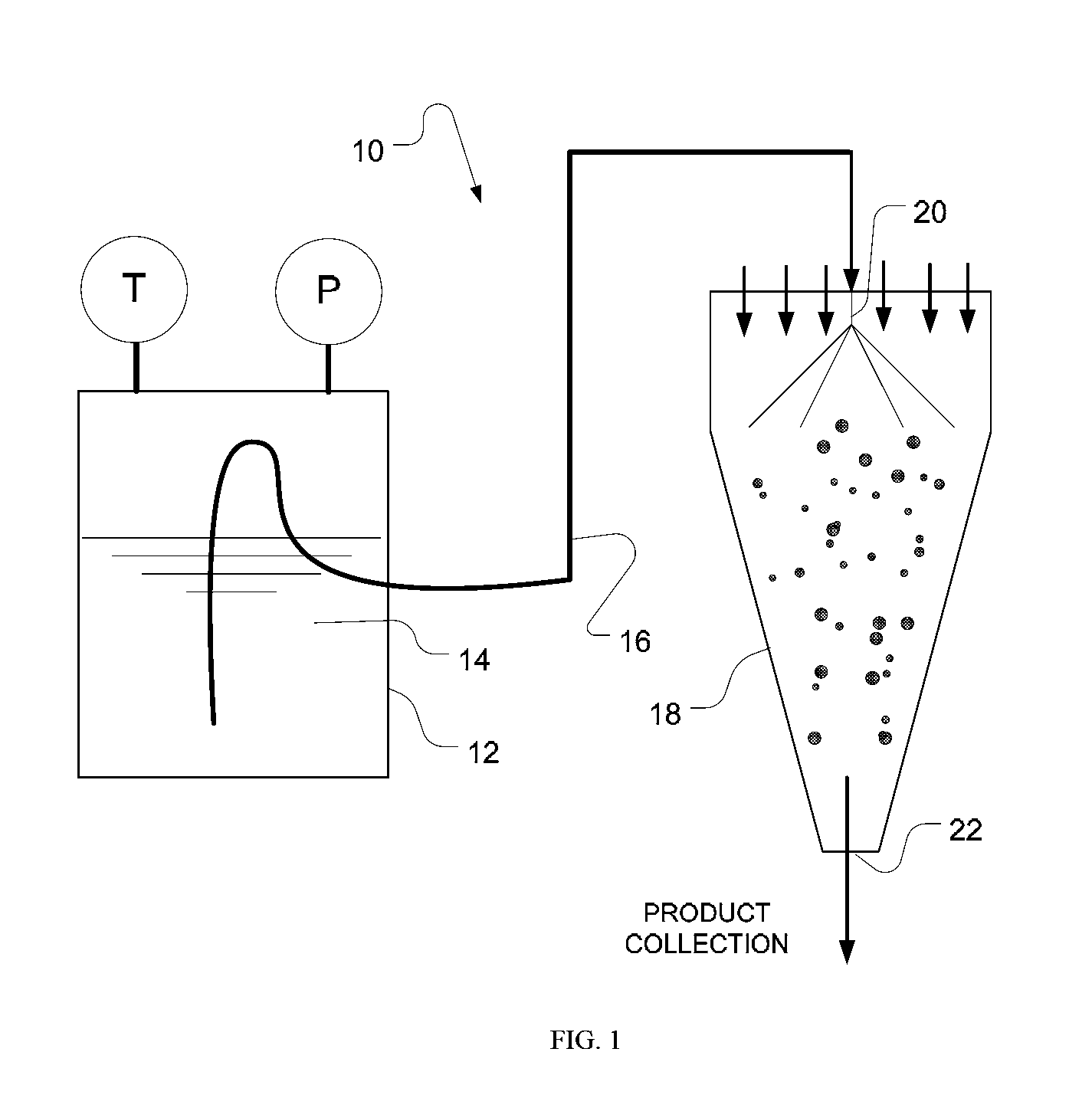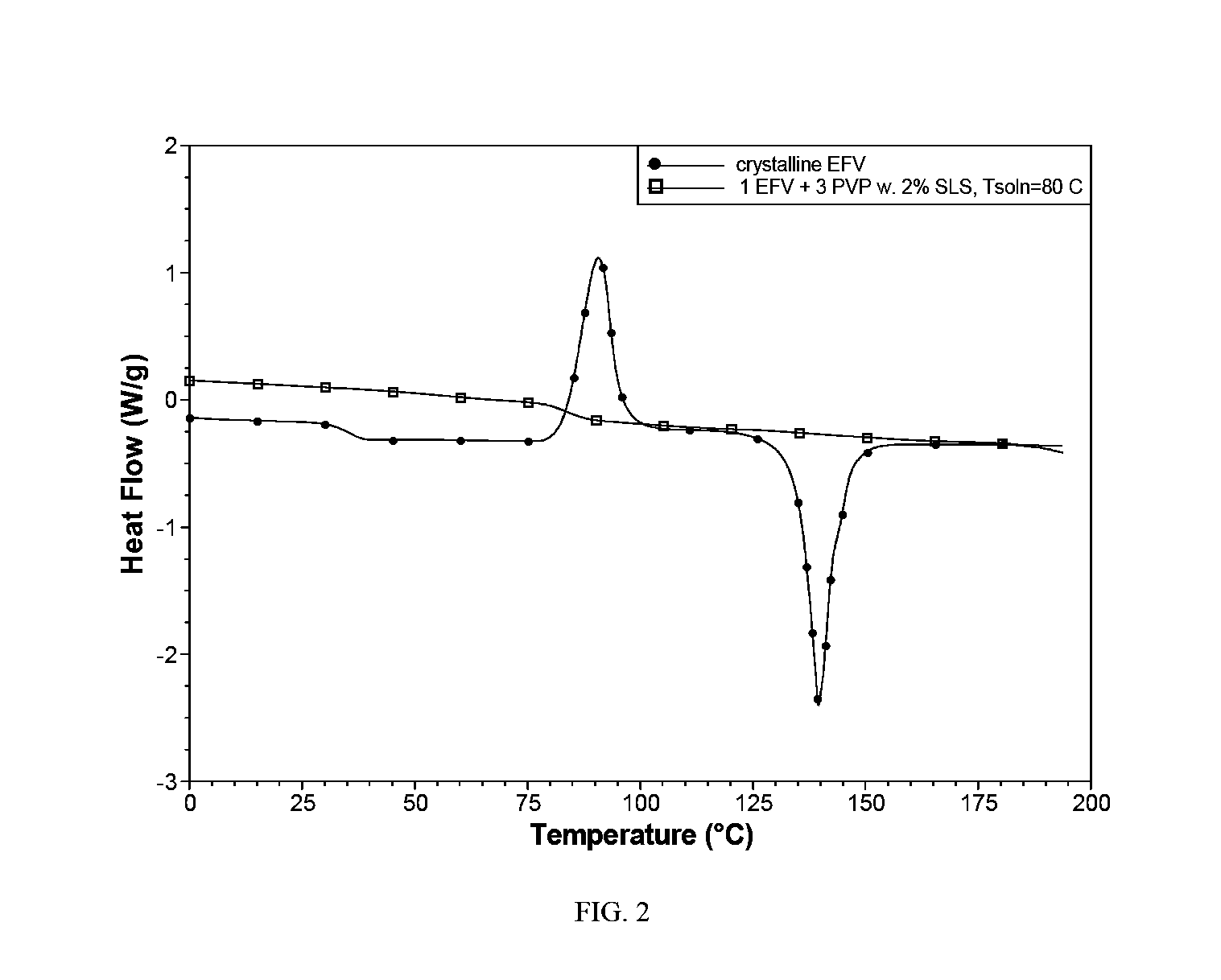Formulation process method to produce spray dried products
a technology of formulation process and spray drying product, which is applied in the direction of organic active ingredients, pharmaceutical delivery mechanisms, synthetic polymeric active ingredients, etc., can solve the problems of otherwise impossible creation using conventional technologies, achieve the effects of improving process operation and product performance, reducing or eliminating difficult-to-use and/or toxic solvents
- Summary
- Abstract
- Description
- Claims
- Application Information
AI Technical Summary
Benefits of technology
Problems solved by technology
Method used
Image
Examples
example 1
[0087]A. A dispersion was made containing 1 efavirenz (EFV): 3 polyvinylpyrrolidone (PVP) and 2% sodium lauryl sulfate (SLS) in 10% dichloromethane, 90% acetone at 10% total solids. A true solution was not created with this amount of acetone, which is a non-solvent for PVP under ambient conditions.
[0088]B. The dispersion was placed into a pressure vessel (Parr Instrument Co.) and heated to 80° C. and 25 psig. Under these conditions the PVP dissolved, yielding a clear, true solution.
[0089]C. The heated solution was evacuated to a spray dryer (SD-Micro®, Niro Inc.) operating with a two-fluid nozzle. The process gas was heated to an inlet temperature of 65° C.
[0090]D. A powder collected in the cyclone jar and had a total residual solvent content of 3.2%.
[0091]E. Analysis of efavirenz crystallinity by DSC (Q1000®, TA Instruments) showed the complete absence of an efavirenz melt endotherm at about 139° C. The spray dried powder contained only completely amorphous efavirenz (FIG. 2).
[0092...
example 2
[0093]A. A second powder was produced using the method described in Example 1, except the dispersion was heated to 105° C. at 50 psig to produce a clear, true solution.
[0094]B. A powder collected in the cyclone jar and had a total residual solvent content of 6.2%.
[0095]C. Analysis of efavirenz crystallinity by DSC (Q1000®, TA Instruments) showed the complete absence of an efavirenz melt endotherm at about 139° C. The spray dried powder contained only completely amorphous efavirenz (FIG. 4).
[0096]D. Based on scanning electron microscopy, the powder produced by this formulation and method had a particle size of about less than 10 μm (FIGS. 5A and 5B). Particles are substantially collapsed with extensive folds such that the particles are not spheres.
example 3
[0097]A. The dissolution properties of both amorphous compositions were tested and compared to crystalline EFV. An amount equivalent to 50 mg efavirenz was analyzed. Powders were hand-filled into size 1 hard gelatin capsules (Shinogi Qualicaps) with an additional 15% croscarmellose sodium (Ac-Di-Sol®, FMC BioPolymers). USP apparatus II (paddles) (VK 7010®, Varian Inc.) was used, with a bath temperature of 37° C. and a paddle speed of 50 rpm for 60 minutes.
[0098]B. Each of the amorphous powders from Examples 1 and 2 achieved higher rate of release and maximum aqueous concentration than the crystalline form (FIG. 6, Table 2). The initial rate of release from the amorphous powders was more than 10-times higher than the crystalline form. The amorphous product spray dried from a solution temperature of 105° C. yielded essentially complete release of this poorly water-soluble drug.
TABLE 2A comparison of dissolution properties for Example 3.rate ofrelease, 0-15 mincomposition(mg / min)extent...
PUM
| Property | Measurement | Unit |
|---|---|---|
| temperature | aaaaa | aaaaa |
| pressure | aaaaa | aaaaa |
| size | aaaaa | aaaaa |
Abstract
Description
Claims
Application Information
 Login to View More
Login to View More - R&D
- Intellectual Property
- Life Sciences
- Materials
- Tech Scout
- Unparalleled Data Quality
- Higher Quality Content
- 60% Fewer Hallucinations
Browse by: Latest US Patents, China's latest patents, Technical Efficacy Thesaurus, Application Domain, Technology Topic, Popular Technical Reports.
© 2025 PatSnap. All rights reserved.Legal|Privacy policy|Modern Slavery Act Transparency Statement|Sitemap|About US| Contact US: help@patsnap.com



